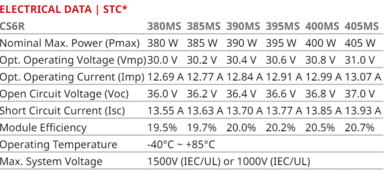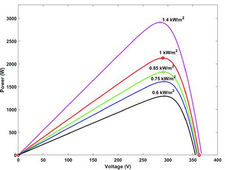Hello,
I recently purchased a solar inverter kit, growatt 3500tl lvm-us and a SOK 48v 100ah, with 4 PV modules (each module rated for 380-405w at max 36.6v).
It appears the combined 4 PV modules are not quite good enough to reach the Growatt 3500's startup voltage of 150vdc.
I called Growatt and their US support confirmed that 150v from the PV array is required, he said sometimes it'll work with a little less (I assume this has to do with Voc vs. closed circuit).
That leaves me in a bind because my 4 modules produce a max combined Voc of 146.4v. That might be enough to startup the growatt 3500 during a super optimal environment, but not good enough in my (inexperienced) mind. Side note: I've reached out to the store I purchased the kit from, I'm waiting for a response.
I am trying to avoid buying a 5th panel due to lack of mounting locations and lack of stock for a matching panel, they are out of stock right now.
If I used a victron mppt charge controller rated at 150v PV input and 35amps, I could charge the battery with it and while the all in one growatt inverter wouldn't do any PV charging, it could still act as my AC input from my generator when required. So long as I don't max out the SOK battery input amperage by having 2 different chargers running at the same time, that would work right?
Anyone know what the minimum PV array voltage needs to be for the victron 150/35 to charge? *edit* I just found out, it charges when PV is at least Vbat + 5v.
I also wondered, in the above scenario with the generator NOT running, if the Victron mppt is charging the battery and the growatt has an AC load, does the growatt utilize the power coming in from the Victron and the battery at the same time or how does it pull power?
For example, the Victron could be throwing 30amps at the battery in excellent sunny conditions, and then I power on say 10amps of AC devices, where does the power draw from, victron or the battery?
Thank you,
Bill
I recently purchased a solar inverter kit, growatt 3500tl lvm-us and a SOK 48v 100ah, with 4 PV modules (each module rated for 380-405w at max 36.6v).
It appears the combined 4 PV modules are not quite good enough to reach the Growatt 3500's startup voltage of 150vdc.
I called Growatt and their US support confirmed that 150v from the PV array is required, he said sometimes it'll work with a little less (I assume this has to do with Voc vs. closed circuit).
That leaves me in a bind because my 4 modules produce a max combined Voc of 146.4v. That might be enough to startup the growatt 3500 during a super optimal environment, but not good enough in my (inexperienced) mind. Side note: I've reached out to the store I purchased the kit from, I'm waiting for a response.
I am trying to avoid buying a 5th panel due to lack of mounting locations and lack of stock for a matching panel, they are out of stock right now.
If I used a victron mppt charge controller rated at 150v PV input and 35amps, I could charge the battery with it and while the all in one growatt inverter wouldn't do any PV charging, it could still act as my AC input from my generator when required. So long as I don't max out the SOK battery input amperage by having 2 different chargers running at the same time, that would work right?
Anyone know what the minimum PV array voltage needs to be for the victron 150/35 to charge? *edit* I just found out, it charges when PV is at least Vbat + 5v.
I also wondered, in the above scenario with the generator NOT running, if the Victron mppt is charging the battery and the growatt has an AC load, does the growatt utilize the power coming in from the Victron and the battery at the same time or how does it pull power?
For example, the Victron could be throwing 30amps at the battery in excellent sunny conditions, and then I power on say 10amps of AC devices, where does the power draw from, victron or the battery?
Thank you,
Bill




